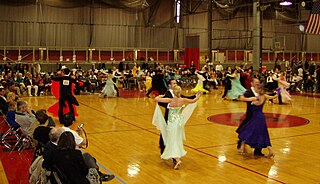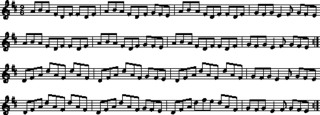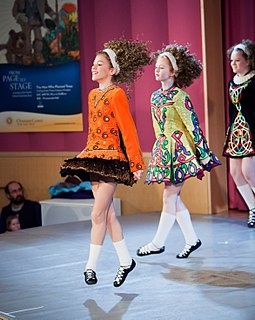
Irish dance refers to a group of traditional dance forms originating from Ireland, encompassing dancing both solo and in groups, and dancing for social, competitive, and performance purposes. Irish dance in its current form developed from various influences such as earlier native Irish dance, English country dancing and later possibly French quadrilles, as it became popular in Britain and Ireland during the 19th Century. Dance was taught by "travelling dance masters" across Ireland in the 17th-18th century, and separate dance forms developed according to regional practice and differing purposes. Irish dance became a significant part of Irish culture, particularly for Irish nationalist movements. From the early 20th century, a number of organisations promoted and codified the various forms of dance, creating competitive structures and standardised styles. Irish dancers who compete for competitive reasons dance in a dance style that's more modern than traditional Irish dance. It is mainly done solo, but there is some team dancing in groups of 2, 3, 4, 6, 8, 10, 16 and even numbers on wards. Competitive Irish dancers wear dresses heavily crystalled in Swarvoski and beam on stage. Competitive Irish dancers may also wear large wigs and stage makeup.

Dancesport is competitive ballroom dancing, as contrasted to social or exhibition dancing. In the case of wheelchair dancesport, at least one of the dancers is in a wheelchair.

Step dance is a generic term for dance styles in which footwork is considered to be the most important part of the dance and limb movements and styling are either restricted or considered irrelevant.

Slip jig refers to both a style within Irish music, and the Irish dance to music in slip-jig time. The slip jig is in 9
8 time, traditionally with accents on 5 of the 9 beats — two pairs of crotchet/quaver followed by a dotted crotchet note.

Drum Corps International (DCI) is a governing body for junior drum and bugle corps based in Indianapolis, Indiana. DCI is responsible for developing and enforcing rules of competition, and for providing standardized adjudication, at sanctioned competitions throughout the United States and Canada.

Drum Corps Europe (DCE) is a governing body for all-age drum and bugle corps based in Biddinghuizen, Netherlands. DCE coordinates the European Music Games, including the annual European Championships, in cooperation with strategic partners from the United Kingdom, Ireland, and Germany. DCE also hosts the Dutch Music Games which were previously hosted by the defunct Drum Corps Nederland (DCN). Also known as European Drum Corps Association (EDCA).

Highland dance or Highland dancing is a style of competitive dancing developed in the Scottish Highlands in the 19th and 20th centuries, in the context of competitions at public events such as the Highland games. It was created from the Gaelic folk dance repertoire, but formalised with the conventions of ballet', and has been subject to influences from outside the Highlands. Highland dancing is often performed with the accompaniment of Highland bagpipe music, and dancers wear specialised shoes called ghillies. It is now seen at nearly every modern-day Highland games event.
A Feis or Fèis is a traditional Gaelic arts and culture festival. The plural forms are feiseanna and fèisean. The term feis is commonly used referring to Irish dance competitions and, in Scotland, to immersive teaching courses, specialising in traditional music and culture. In Scottish Gaelic, the accent is important because there is a difference of meaning and pronunciation between feis and fèis — the word feis means sexual intercourse.

Baton twirling is an art involving the manipulation of a metal rod and the performer's body to a coordinated routine. It is similar to rhythmic gymnastics or color guard.

Irish stepdance is a style of performance dance with its roots in traditional Irish dance. It is generally characterized by a stiff upper body and fast and precise movements of the feet. It can be performed solo or in groups. Aside from public dance performances, there are also stepdance competitions all over the world. These competitions are often called Feiseanna. In Irish dance culture, a Feis is a traditional Gaelic arts and culture festival. Costumes are considered important for stage presence in competition and performance Irish stepdance. In many cases, costumes are sold at high prices and can even be custom made. Males and females can both perform Irish stepdance but for the most part in today's society, the dance remains predominantly female. This means that the costumes are mainly dresses. Each dress is different, with varying colors and patterns, designed to attract the judge's eye in competitions and the audience's eye in performance. General appearance beside the costume is also equally important. Dancers would typically curl their hair before each competition. Many dancers invest in curled wigs that match their hair color. Poodle Socks are worn with the dresses and shoes. These are white socks that stretch to mid-calf with distinctive ribbing.
In modern competitive Irish dance, an oireachtas refers to an annual championship competition. Oireachtais are held by several Irish dance organisations globally, including An Coimisiún Le Rincí Gaelacha, An Comhdhail na Múinteoirí le Rincí Gaelacha, the World Irish Dance Association, and others. Many oireachtais include both solo and ceilí (team) events. The competitions vary in size, duration, and level of eligibility.
Dean Crouch is an Irish dancer and musician. At the age of 12 he was Great Britain Champion, British National Champion, All Scotland Champion, All Ireland Champion, North American Champion and the World Champion, winning with a score of 900 out of a possible 900.
Festival dance is a form of Irish dance traditionally associated with Northern Ireland. It separated from the "feis" movement in stepdancing in the mid-20th century and became stylistically and administratively distinct. The form is practised competitively in Northern Ireland, England, and parts of mainland Europe.

Jig is a 2011 documentary produced and directed by Sue Bourne about the world of Irish dance and the fortieth Irish Dancing World Championships, held in March 2010 in Glasgow.

Róisín Mullins is a TV presenter, TV talent show judge, professional Irish dancer, singer, stage show owner and choreographer.

An Coimisiún Le Rincí Gaelacha is the oldest and largest governing body for competitive Irish step dancing globally. Founded in 1927, CLRG is responsible for creating a standardised system of Irish dance, music and competition for its member organisations in 26 countries. It organises Oireachtas Rince na Cruinne as well as Oireachtas Rince na hÉireann, and is the central authority for teacher and adjudicator accreditation. It is headquartered in Dublin, Ireland.

Comhdháil na Múinteoirí le Rincí Gaelacha, also referred to as An Chomhdháil, is a global governing body for Irish stepdance. Founded in the early 1960s, and then breaking from An Coimisiún Le Rincí Gaelacha to become an independent organisation, An Chomhdháil is today the second-largest Irish dance organisation and one of six to run a World Championships competition.

Oireachtas Rince na Cruinne is an annual Irish stepdance competition run by An Coimisiún Le Rincí Gaelacha. The Worlds include competitions for solo stepdance, organised by gender and age; and for certain traditional and original ceili dances, also divided by age group and team gender composition. Oireachtas Rince na Cruinne is the top competition of the hierarchical system operated by An Coimisiún, and dancers must qualify at major Irish stepdance events across the world in order to compete.
Julia O'Rourke is a former competitive Irish stepdancer. After being featured in the 2010 Sue Bourne documentary Jig as a competitor at the 2010 Oireachtas Rince na Cruinne, O'Rourke became known as a public face for the dance form globally. She won several further titles before her retirement from competition in 2017.
Conor Simpson is a competitive performer of Irish stepdance from Canberra, Australia. Having begun dancing at his mother's school at the age of nine, Simpson has been highly successful in local and international competition. He is one of the few Australians to win a title at Oireachtas Rince na Cruinne, and has also performed professionally.















